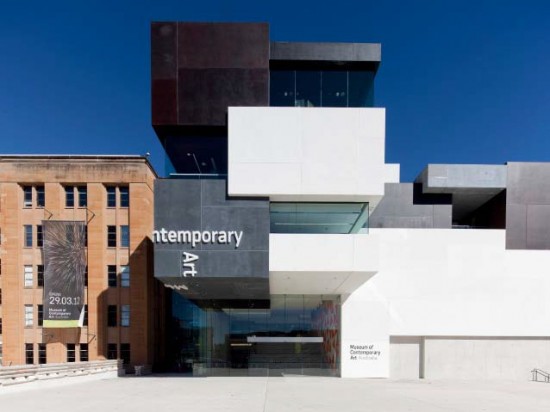The MCA's new Mordant Wing

Exterior of the new MCA on Circular Quay West. Image courtesy Museum of Contemporary Art, Sydney. Photograph: Brett Boardman.
The Museum of Contemporary Art (MCA) has been at the centre of one of the art world’s most heated debates: the verdict on the new Mordant Wing of course. It is to be expected that when such an historically rich art museum undergoes a controversial stylistic redevelopment that it be met with flamboyant responses.
In celebration of the MCA’s new wing, we thought it only fitting to join the discussion by imparting our thoughts – both praises and criticisms – on the space itself and the exciting new work housed within it. Let us first however, place the debate within its rightful historical and cultural context.
The MCA opened its doors to the public in 1991 through a bequest by Australian expatriate artist John Power. Nestled on the edge of Sydney Harbour, the sandstone art deco building (formerly the Maritime Services Board headquarters) became the newest host of Australia’s most forward thinking collection of contemporary art.
Emerging at a time when Sydney Harbour was transitioning from a place of commerce and transportation to culture and leisure, the museum encouraged a new way for art to engage with the new multiplicity of meanings in Australian ethnicity.
Perched on a site that constituted the first contact between Indigenous and European peoples as well as the country’s colonial history, the MCA was drenched in historical currency, which with the introduction of the new wing, some believe has come under threat.
Sydney based architect Sam Marshall (in partnership with NSW Government Architect’s Office) has offered up the sparkly new addition that has seen the museum venture into new territory. The new Mordant Wing is clad in glass reinforced concrete panels and recalls the modular design aesthetic so prominent in the 60s.
Known for his award-winning design involving a warehouse conversion in Darlinghurst, it comes as no surprise that Marshall’s architectural language is informed by a dialogue between old and new.
If we agree with former Chief Curator, Bernice Murphy’s proclamation that the old building represents a, “stodgy public mentality of provincial civil architecture,” we should then also be inclined to believe the Mordant Wing to have enhanced the museum’s advocacy of avant-garde architecture.
The facts tell us that the new wing cost $53 million, that it increases the MCA’s total size by almost 50 percent with three new galleries, that there is a Sculpture Terrace and two function rooms on the upper levels of the building, and that it demonstrates the museum’s fondness of furthering artistic education through a National Centre for Creative Learning and networked video conferencing facilities and digital infrastructure.
Housekeeping aside, the new wing has polarised people. Much alike a shoulder-pad for the MCA’s rather banal counterpart, the new wing epitomises the ‘contemporary’, but many beg the question of for just how long? A matter of visual identity, the Mordant Wing’s exterior aesthetic is just one of the architectural markers we should consider when evaluating the museum’s new addition.
When looking at spatial implications of the design, we need to ask whether the new wing enhances the art without overshadowing it. Yes, there is more space, but unfortunately the new galleries don’t feel much bigger, which in turn makes us aware of our circulation throughout the museum. Depending on personal preference, one’s awareness of their own act of ‘gazing’ could detract from the overall experience of what’s on offer by setting back the level of immersion.
Contrary to this, the MCA’s new entrance on George Street is a clear spatial triumph. Entering through the space, which seamlessly connects George Street and the museum’s boisterous Quay side stairs, visitors feel welcomed. The space buzzes with commotion and the MCA’s audience acknowledge their presence in the newly opened wing. Or should the entrance remain central to the overall museum rather than relegated to one side of the old building?
Despite the new wing having divided people, the Mordant Wing in our opinion, successfully fuses the old with the new by forging innovative ways through which audiences can interact with and understand the work on offer. In a turbulent artistic climate, Marshall’s design cleverly distills the MCA’s paradox wherein contemporary art is homed by a building steeped in colonial heritage.
The Mordant Wing signals the MCA’s transformation into a world class institution – an institution with a renewed soul that will no longer be overlooked by large shows who have previously dismissed the space due to its inability to house touring blockbusters adequately.
Share with us your verdict on the new Mordant Wing by leaving a comment.

4 Comments
Error thrown
Call to undefined function ereg()